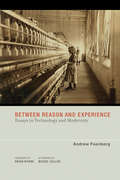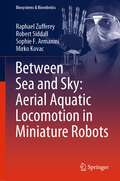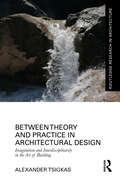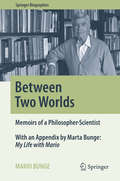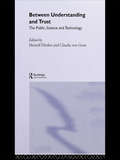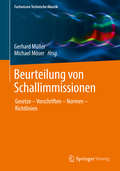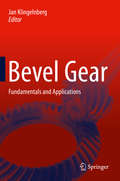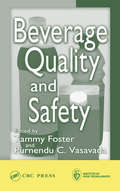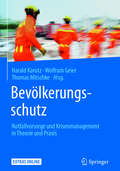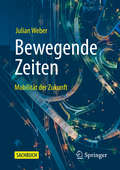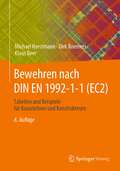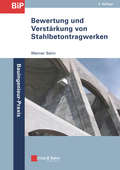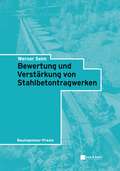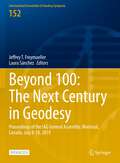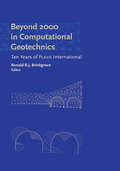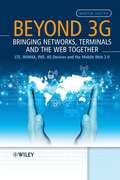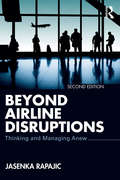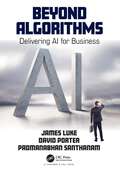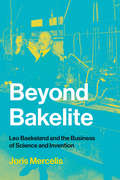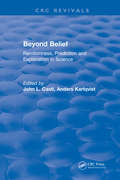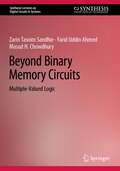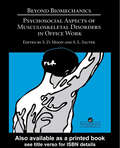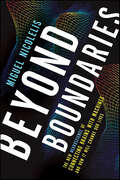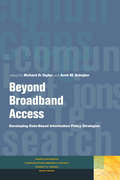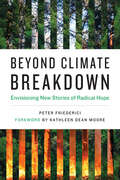- Table View
- List View
Between Reason and Experience: Essays in Technology and Modernity (Inside Technology)
by Andrew FeenbergA leading philosopher of technology calls for the democratic coordination of technical rationality with everyday experience.The technologies, markets, and administrations of today's knowledge society are in crisis. We face recurring disasters in every domain: climate change, energy shortages, economic meltdown. The system is broken, despite everything the technocrats claim to know about science, technology, and economics. These problems are exacerbated by the fact that today powerful technologies have unforeseen effects that disrupt everyday life; the new masters of technology are not restrained by the lessons of experience, and accelerate change to the point where society is in constant turmoil. In Between Reason and Experience, leading philosopher of technology Andrew Feenberg makes a case for the interdependence of reason—scientific knowledge, technical rationality—and experience. Feenberg examines different aspects of the tangled relationship between technology and society from the perspective of critical theory of technology, an approach he has pioneered over the past twenty years. Feenberg points to two examples of democratic interventions into technology: the Internet (in which user initiative has influenced design) and the environmental movement (in which science coordinates with protest and policy). He examines methodological applications of critical theory of technology to the case of the French Minitel computing network and to the relationship between national culture and technology in Japan. Finally, Feenberg considers the philosophies of technology of Heidegger, Habermas, Latour, and Marcuse. The gradual extension of democracy into the technical sphere, Feenberg argues, is one of the great political transformations of our time.
Between Sea and Sky: Aerial Aquatic Locomotion in Miniature Robots (Biosystems & Biorobotics #29)
by Raphael Zufferey Robert Siddall Sophie F. Armanini Mirko KovacThis book reports on the state of the art in the field of aerial-aquatic locomotion, focusing on the main challenges concerning the translation of this important ability from nature to synthetic systems, and describing innovative engineering solutions that have been applied in practice by the authors at the Aerial Robotics Lab of Imperial College London. After a general introduction to aerial-aquatic locomotion in nature, and a summary of the most important engineering achievements, the book introduces readers to important physical and mathematical aspects of the multimodal locomotion problem. Besides the basic physics involved in aerial-aquatic locomotion, the role of different phenomena happening in fluids, or those due to structural mechanics effects or to power provision, are presented in depth, across a large dimension range, from millimeters to hundreds of meters. In turn, a practice-oriented discussion on the obstacles and opportunities of miniaturization, for both robots and animals is carried out. This is followed by applied engineering considerations, which describe relevant hardware considerations involved in propulsion, control, communication and fabrication. Different case studies are analyzed in detail, reporting on the latest research carried out by the authors, and covering topics such as propulsive aquatic escape, the challenging mechanics of water impact, and a hybrid sailing and flying aircraft. Offering extensive and timely information on the design, construction and operation of small-scale robots, and on multimodal locomotion, this book provides researchers, students and professionals with a comprehensive and timely reference guide to the topic of aerial-aquatic locomotion, and the relevant bioinspired approaches. It is also expected to inspire future research and foster a stronger multidisciplinary discussion in the field.
Between Theory and Practice in Architectural Design: Imagination and Interdisciplinarity in the Art of Building (Routledge Research in Architecture)
by Alexander TsigkasBetween Theory and Practice in Architectural Design: Imagination and Interdisciplinarity in the Art of Building examines the intersection of philosophy and practice in architecture, exploring life, viability, and interdisciplinary collaboration and offering practical design insights for all beings.This book highlights several key architectural features, including a philosophical exploration of life, a focus on creating organic spaces, and the use of the viable system model (VSM) for organisational resilience. Additionally, it emphasises interdisciplinary design thinking and introduces a platform for viable and agile AI-assisted design. The book provides practical case studies highlighting how theory and practice can be integrated into architectural projects, giving architects actionable insights for innovative, adaptive, and purposeful design. By utilising organic design principles and interdisciplinary collaboration, readers will gain a transformative understanding of architecture. The book encourages the application of the viable system model to enhance organisational viability while promoting flexibility and viability in design. Furthermore, architects are encouraged to use logic-based and object-oriented ontology (OOO)-based AI-assisted design approaches due to their ability to evaluate design scenarios quickly.This book will be of interest to architects, designers, and enthusiasts seeking a comprehensive understanding of architecture, and professionals in architectural enterprises looking to enhance organisational viability will find value. Interdisciplinary collaboration is emphasised throughout the book. Students and academics in architecture and related fields will also benefit from its philosophical exploration and practical insights.
Between Two Worlds: Memoirs of a Philosopher-Scientist (Springer Biographies)
by Mario BungeTo go through the pages of the Autobiography of Mario Bunge is to accompany him through dozens of countries and examine the intellectual, political, philosophical and scientific spheres of the last hundred years. It is an experience that oscillates between two different worlds: the different and the similar, the professional and the personal. It is an established fact that one of his great loves was, and still is, science. He has always been dedicated to scientific work, teaching, research, and training men and women in multiple disciplines. Life lessons fall like ripe fruit from this book, bringing us closer to a concept, a philosophical idea, a scientific digression, which had since been uncovered in numerous notes, articles or books. Bunge writes about the life experiences in this book with passion, naturalness and with a colloquial frankness, whether they be persecutions, banishment, imprisonment, successes, would-be losses, emotions, relationships, debates, impressions or opinions about people or things. In his pages we pass by the people with whom he shared a fruitful century of achievements and incredible depths of thought. Everything is remembered with sincerity and humor. This autobiography is, in truth, Bunge on Bunge, sharing everything that passes through the sieve of his memory, as he would say. Mario's many grandchildren are a testament to his proud standing as a family man, and at the age of 96 he gives us a book for everyone: for those who value the memories that hold the trauma of his life as well as for those who share his passion for science and culture. Also, perhaps, for some with whom he has had disagreements or controversy, for he still deserves recognition for being a staunch defender of his convictions.
Between Understanding and Trust: The Public, Science and Technology
by Meinolf Dierkes Claudia Von Grote'This is a welcome book. The issues of public understanding of science open many questions. What does "understanding" mean? How does understanding translate into attitudes towards science and trust in scientists? What is the role of the mass media? The essays in this book shed light on such questions bringing insights from several disciplines. They help to define a meaningful research agenda for the future. - Professor Dorothy Nelkin, New York University
Beurteilung von Schallimmissionen: Gesetze – Vorschriften – Normen – Richtlinien (Fachwissen Technische Akustik)
by Michael Möser Gerhard MüllerDieser Band der Reihe Fachwissen Technische Akustik beschreibt das Ausmaß von Lärmwirkungen mit Hilfe objektivierbarer Einflussfaktoren. Die behandelten Themen dienen dazu, Aussagen zu treffen, ob angestrebte Schutzziele, wie z.B. die Vermeidung erheblicher Belästigungen oder die Gewährleistung einer guten Sprachverständlichkeit, erreicht werden.
Bevel Gear: Fundamentals and Applications
by Jan KlingelnbergThis is the first book to offer a complete presentation of bevel gears. An expert team of authors highlights the areas of application for these machine elements and presents the geometrical features of bevel gears as well as the various gear cutting processes based on gear cutting theory. The aspect of three-dimensional gearing is assessed in detail in terms of flank design, load capacity and noise behavior. A representation of production processes with the required technologies provides a knowledge base on which sound decisions can be based. The authors offer a thorough introduction to the complex world of bevel gears and present the rapid advances of these machine elements in a detailed, comprehensible manner. This book addresses design engineers in mechanical engineering and vehicle manufacturing, as well as producers of bevel gears and students in mechanical engineering.
Beverage Quality and Safety
by Tammy Foster Purnendu C. VasavadaBased on an IFT short course, Beverage Quality and Safety offers information on the latest beverage industry trends related to products, processing, and packaging technologies - including new generation nutraceutical beverages. It also covers important regulatory issues, including federal regulations on HACCP. Among the topical issues it addresses
Bevölkerungsschutz: Notfallvorsorge und Krisenmanagement in Theorie und Praxis
by Harald Karutz Wolfram Geier Thomas MitschkeDieses interdisziplin#65533;re Lehrbuch und Nachschlagewerk gibt einen klar strukturierten, orientierenden #65533;berblick #65533;ber Aufgaben, Strukturen, Organisationen und Akteure in den unterschiedlichen Bereichen von Notfallvorsorge und Gefahrenabwehr. Thematisiert werden sowohl natur- und ingenieurwissenschaftliche als auch sozial- und humanwissenschaftliche Aspekte des Risiko- und Katastrophenmanagements, sodass der Bev#65533;lkerungsschutz in Deutschland als eine klassische Querschnittsaufgabe erscheint. Das Werk leistet einen wesentlichen Beitrag zur Entwicklung #65533;bergreifender Reflexions- und Entscheidungskompetenz f#65533;r Risiko- und Katastrophenmanager, Rettungs- und Sicherheitsingenieure, Emergency Practitioner, Fachberater, Einsatzleiter und weitere F#65533;hrungskr#65533;fte.
Bewegende Zeiten: Mobilität der Zukunft
by Julian WeberSitzen wir wirklich schon bald nicht mehr selbst am Steuer unseres Autos, sondern werden nur noch von fahrerlosen Elektro-Taxis ans Ziel gebracht? Sollen Städte Car Sharing einführen? Welche Rolle werden Elektroroller, Seilbahnen oder manntragende Drohnen in den Mobilitätssystemen der Großstädte spielen? Dieses Buch erklärt endlich allgemeinverständlich, was sich hinter Schlagworten wie Elektromobilität, autonomes Fahren, Digitalisierung und Mobilitätsdienstleistungen wie Car Sharing oder Ride Hailing wirklich verbirgt, wie weit fortgeschritten diese Technologien heute sind, und vor allem auch in welchen Beziehungen und Abhängigkeiten diese zueinander stehen. Dabei werden neben den technischen auch die gesetzgeberischen und gesellschaftlichen Trends betrachtet, die als wichtige Rahmenbedingungen die Mobilität der Zukunft maßgeblich mitbestimmen.Aus dem Inhalt• Mobilitätsbedarfe: Wer will alles wann, warum wohin – und wie wird sich das in Zukunft ändern?• Technologische Trends: Elektromobilität, Digitalisierung, Autonomes Fahren – was werden die Fahrzeuge der Zukunft können?• Car Sharing, Ride Hailing, E-Scooter oder doch öffentlicher Nahverkehr: Welche Alternativen zum eigenen Pkw wird es in Zukunft geben?• Politik und Gesellschaft: Wie werden sich die Rahmenbedingungen der Mobilität in Zukunft entwickeln?• Mobilität im Wandel: Was sollten wir tun, um uns auf die Zukunft vorzubereiten?
Bewehren nach DIN EN 1992-1-1 (EC2): Tabellen und Beispiele für Bauzeichner und Konstrukteure
by Klaus Beer Michael Horstmann Dirk RoemersDieses Fachbuch bietet einen schnellen und übersichtlichen Einblick in die Bewehrung von baupraktisch häufig verwendeten Stahlbetonbauteilen. Wie viele Stabstähle kommen in einen Balken? In welche Richtung wird eine Q-Matte verlegt? Die Autoren erklären mit verständlichem Text und anschaulichen Abbildungen, nach welchen Regeln der Betonstahl im Beton verlegt und wie er zeichnerisch dargestellt wird. Zahlreiche Tabellen und Beispiele ermöglichen schnelle Hilfe bei der Erstellung eigener Bewehrungszeichnungen. Dieses Buch ist somit besonders für Bauzeichner und Konstrukteure, aber auch für (Jung)Ingenieure geeignet und bietet zuverlässige Hilfe in Ausbildung und Praxis. In dieser 8. Auflage wurde die Struktur des Buches stringenter gestaltet. Die zahlreichen Bewehrungsbeispiele wurden überarbeitet und auf den aktuellen Stand des EC2 und der zugehörigen DAfStb-Hefte gebracht. Zusätzlich wird das Kapitel WU-Betonbauwerke vertieft dargestellt.
Bewertung und Verstärkung von Stahlbetontragwerken (Bauingenieur-Praxis)
by Werner SeimDer Umgang mit vorhandener Bausubstanz gehört zu den täglichen Aufgaben für Bauingenieure und Architekten. Das vorliegende Buch vermittelt die notwendigen Kenntnisse der verschiedenen Methoden der Zustandserfassung und Bewertung von Bauteilen und Tragwerk sowie der Planung von Instandsetzungs- und Ertüchtigungsmaßnahmen. Ein Überblick über die Entwicklung der Bemessungsregeln und Materialkennwerte im Stahlbetonbau hilft bei der Auswertung von Bestandsunterlagen. Zahlreiche anschauliche Beispiele machen das Buch zu einem unverzichtbaren Leitfaden für die Planung und zu einem wertvollen Begleiter für das Studium. Für die zweite Auflage wurden die Inhalte mit Bezug zu den gültigen technischen Regelwerken vollständig aktualisiert. Darüber hinaus wurden einige Teile zum besseren Verständnis vollständig überarbeitet und neue Abschnitte aufgenommen.
Bewertung und Verstärkung von Stahlbetontragwerken (Bauingenieur-Praxis)
by Werner SeimStrengthening of existing structures is an increasing area of work for practising structural design engineers. The book delivers the necessary knowledge about various methods of recording the condition of existing elements and structures and the design of strengthening measures.
Beyond 100: Proceedings of the IAG General Assembly, Montreal, Canada, July 8-18, 2019 (International Association of Geodesy Symposia #152)
by Jeffrey T. Freymueller Laura SánchezThis open access book contains 30 peer-reviewed papers based on presentations at the 27th General Assembly of the International Union of Geodesy and Geophysics (IUGG). The meeting was held from July 8 to 18, 2019 in Montreal, Canada, with the theme being the celebration of the centennial of the establishment of the IUGG. The centennial was also a good opportunity to look forward to the next century, as reflected in the title of this volume. The papers in this volume represent a cross-section of present activity in geodesy, and highlight the future directions in the field as we begin the second century of the IUGG. During the meeting, the International Association of Geodesy (IAG) organized one Union Symposium, 6 IAG Symposia, 7 Joint Symposia with other associations, and 20 business meetings. In addition, IAG co-sponsored 8 Union Symposia and 15 Joint Symposia. In total, 3952 participants registered, 437 of them with IAG priority. In total, there were 234 symposia and 18 Workshops with 4580 presentations, of which 469 were in IAG-associated symposia.
Beyond 2000 in Computational Geotechnics
by Ronald B.J. BrinkgreveThis volume contains papers presented during the first international PLAXIS symposium. Topics covered include: general geo-technical aspects; tunnels and deep excavations, and education and research. This pack is meant for the user of the PLAXIS program, as well as engineers and researchers.
Beyond 3G - Bringing Networks, Terminals and the Web Together
by Martin SauterGiving a sound technical introduction to 3GPP LTE and SAE, this book explains the decisions taken during standardization while also examining the likely competition for LTE such as HSPA+ and WiMAX. As well as looking at next generation network technologies, Beyond 3G - Bringing Networks, Terminals and the Web Together describes the latest mobile device developments, voice and multimedia services and the mobile web 2.0. It considers not only how the systems, devices and software work but also the reasons behind why they are designed in this particular way. How these elements strongly influence each other is discussed as well as how network capabilities, available bandwidth, mobile device capabilities and new application concepts will shape the way we communicate in the future. This book gives an end to end introduction to wireless, from mobile software architecture to core networks, making it a valuable resource for anyone working in the industry.Examines current and next-generation network technologies such as UMTS, HSPA+, WiMAX, LTE and WifiAnalyses and explains performance and capacity in practice as well as future capacity requirements and how they can be fulfilledIntroduces the reader to the current cellular telephony architecture and to voice over IP architectures such as SIP, IMS and TISPANLooks at mobile device hardware and mobile operating system evolutionEncompasses all major global wireless standards for application development and the latest state of the mobile web 2.0
Beyond Airline Disruptions: Thinking and Managing Anew
by Jasenka RapajicFlight disruptions continue to thrive unnoticed, invisibly eroding airline profitability and causing growing passenger dissatisfaction. This is especially critical at airports where traffic expansion outstrips airport capacities. Hampered by legacy information systems, management practices and organisational detachments, decision makers across the industry have little or no understanding of the multiple causes of disruptions and their implications. Consequently, their actions are focused on resolving local problems without being synchronised at system level. As problematic as they are, disruptions create opportunities for learning about system interactions, a solid and appropriate foundation for resolving complex industry issues. Beyond Airline Disruptions explains how airlines can become more competitive by utilising unexplored potential for gradual, consistent and measurable improvements, centred around cost and quality of operational performance. It describes practical methods and techniques essential for turning these ideas into daily practices. This second, revised edition features updated content that introduces a fresh approach to airline management and decision making, more in line with future industry needs. It bridges the gaps between strategy and operations and inspires collaboration between airlines, airports, ATC, service providers and regulators to bring longer-lasting benefits not only for industry participants and passengers, but also for the economy, society and the environment.
Beyond Algorithms: Delivering AI for Business
by David Porter James Luke Padmanabhan SanthanamWith so much artificial intelligence (AI) in the headlines, it is no surprise that businesses are scrambling to exploit this exciting and transformative technology. Clearly, those who are the first to deliver business-relevant AI will gain significant advantage. However, there is a problem! Our perception of AI success in society is primarily based on our experiences with consumer applications from the big web companies. The adoption of AI in the enterprise has been slow due to various challenges. Business applications address far more complex problems and the data needed to address them is less plentiful. There is also the critical need for alignment of AI with relevant business processes. In addition, the use of AI requires new engineering practices for application maintenance and trust. So, how do you deliver working AI applications in the enterprise? Beyond Algorithms: Delivering AI for Business answers this question. Written by three engineers with decades of experience in AI (and all the scars that come with that), this book explains what it takes to define, manage, engineer, and deliver end-to-end AI applications that work. This book presents Core conceptual differences between AI and traditional business applications A new methodology that helps to prioritise AI projects and manage risks Practical case studies and examples with a focus on business impact and solution delivery Technical Deep Dives and Thought Experiments designed to challenge your brain and destroy your weekends
Beyond Bakelite: Leo Baekeland and the Business of Science and Invention (Lemelson Center Studies in Invention and Innovation series)
by Joris MercelisThe changing relationships between science and industry in the late nineteenth and early twentieth centuries, illustrated by the career of the “father of plastics.”The Belgian-born American chemist, inventor, and entrepreneur Leo Baekeland (1863–1944) is best known for his invention of the first synthetic plastic—his near-namesake Bakelite—which had applications ranging from electrical insulators to Art Deco jewelry. Toward the end of his career, Baekeland was called the “father of plastics”—given credit for the establishment of a sector to which many other researchers, inventors, and firms inside and outside the United States had also made significant contributions. In Beyond Bakelite, Joris Mercelis examines Baekeland's career, using it as a lens through which to view the changing relationships between science and industry on both sides of the Atlantic in the late nineteenth and early twentieth centuries. He gives special attention to the intellectual property strategies and scientific entrepreneurship of the period, making clear their relevance to contemporary concerns. Mercelis describes the growth of what he terms the “science-industry nexus” and the developing interdependence of science and industry. After examining Baekeland's emergence as a pragmatic innovator and leader in scientific circles, Mercelis analyzes Baekeland's international and domestic IP strategies and his efforts to reform the US patent system; his dual roles as scientist and industrialist; the importance of theoretical knowledge to the science-industry nexus; and the American Bakelite companies' research and development practices, technically oriented sales approach, and remuneration schemes. Mercelis argues that the expansion and transformation of the science-industry nexus shaped the careers and legacies of Baekeland and many of his contemporaries.
Beyond Belief: Randomness, Prediction and Explanation in Science
by John L. CastiHow can we predict and explain the phenomena of nature? What are the limits to this knowledge process? The central issues of prediction, explanation, and mathematical modeling, which underlie all scientific activity, were the focus of a conference organized by the Swedish Council for the Planning and Coordination of Research, held at the Abisko Research Station in May of 1989. At this forum, a select group of internationally known scientists in physics, chemistry, biology, economics, sociology and mathematics discussed and debated the ways in which prediction and explanation interact with mathematical modeling in their respective areas of expertise. Beyond Belief is the result of this forum, consisting of 11 chapters written specifically for this volume. The multiple themes of randomness, uncertainty, prediction and explanation are presented using (as vehicles) several topical areas from modern science, such as morphogenetic fields, Boscovich covariance, and atmospheric variability. This multidisciplinary examination of the foundational issues of modern scientific thought and methodology will offer stimulating reading for a very broad scientific audience.
Beyond Binary Memory Circuits: Multiple-Valued Logic (Synthesis Lectures on Digital Circuits & Systems)
by Masud H. Chowdhury Zarin Tasnim Sandhie Farid Uddin AhmedThis book provides readers with an overview of the fundamental definitions and features of Multiple-Valued Logic (MVL). The authors include a brief discussion of the historical development of MVL technologies, while the main goal of the book is to present a comprehensive review of different technologies that are being explored to implement multiple-valued or beyond-binary memory circuits and systems. The discussion includes the basic features, prospects, and challenges of each technology, while highlighting the significant works done on different branches of MVL memory architecture, such as sequential circuits, random access memory, Flash memory, etc.
Beyond Biomechanics: Psychosocial Aspects Of Musculoskeletal Disorders In Office Work
by S. D. Moon S. L. SauterThere is now widespread recognition that psychosocial factors play a key role in the aetiology, perpetuation, management and prevention of cumulative trauma disorders CTDs. This text addresses the strength, direction and importance of links between psychosocial factors and CTDs.; The book's contributors examine critically current research data, ide
Beyond Boundaries: The New Neuroscience of Connecting Brains with Machines and How It Will Change Our Lives
by Miguel NicolelisA pioneering neuroscientist shows how the long-sought merger of brains with machines is about to become a paradigm-shifting realityImagine living in a world where people use their computers, drive their cars, and communicate with one another simply by thinking. In this stunning and inspiring work, Duke University neuroscientist Miguel Nicolelis shares his revolutionary insights into how the brain creates thought and the human sense of self—and how this might be augmented by machines, so that the entire universe will be within our reach.Beyond Boundaries draws on Nicolelis's ground-breaking research with monkeys that he taught to control the movements of a robot located halfway around the globe by using brain signals alone. Nicolelis's work with primates has uncovered a new method for capturing brain function—by recording rich neuronal symphonies rather than the activity of single neurons. His lab is now paving the way for a new treatment for Parkinson's, silk-thin exoskeletons to grant mobility to the paralyzed, and breathtaking leaps in space exploration, global communication, manufacturing, and more. Beyond Boundaries promises to reshape our concept of the technological future, to a world filled with promise and hope.
Beyond Broadband Access: Developing Data-Based Information Policy Strategies (Donald McGannon Communication Research Center's Everett C. Parker Book Series)
by Richard D. Taylor Amit M. SchejterAfter broadband access, what next? What role do metrics play in understanding “information societies”? And, more important, in shaping their policies? Beyond counting people with broadband access, how can economic and social metrics inform broadband policies, help evaluate their outcomes, and create useful models for achieving national goals? This timely volume not only examines the traditional questions about broadband, like availability and access, but also explores and evaluates new metrics more applicable to the evolving technologies of information access.Beyond Broadband Access brings together a stellar array of media policy scholars from a wide range of disciplines—economics, law, policy studies, computer science, information science, and communications studies. Importantly, it provides a well-rounded, international perspective on theoretical approaches to databased communications policymaking in the Americas, Europe, Asia, and Africa. Showcasing a diversity of approaches, this invaluable collection helps to meet myriad challenges to improving the foundations for communications policy development.
Beyond Climate Breakdown: Envisioning New Stories of Radical Hope (One Planet)
by Peter FriedericiThe importance of telling new climate stories—stories that center the persistence of life itself, that embrace comedy and radical hope.&“How dare you?&” asked teenage climate activist Greta Thunberg at the United Nations in 2019. How dare the world&’s leaders fiddle around the edges when the world is on fire? Why is society unable to grasp the enormity of climate change? In Beyond Climate Breakdown, Peter Friederici writes that the answer must come in the form of a story, and that our miscomprehension of the climate crisis comes about because we have been telling the wrong stories. These stories are pervasive; they come from long narrative traditions, sanctioned by capitalism, Hollywood, and social media, and they revolve around a myth: that the nation exists primarily as a setting for a certain kind of economic activity. Stories are how we make sense of the world and our place in it. The story that &“the economy&” takes priority over everything else may seem foreordained, but, Friederici explains, actually reflect choices made by specific people out of self-interest. So we need new stories—stories that center the persistence of life, rather than of capitalism, stories that embrace contradiction and complexity. We can create new stories based on comedy and radical hope. Comedy never says no; hope sprouts like a flower in cracked concrete. These attitudes require a new way of thinking—an adaptive attitude toward life that slips the narrow yoke of definition.
